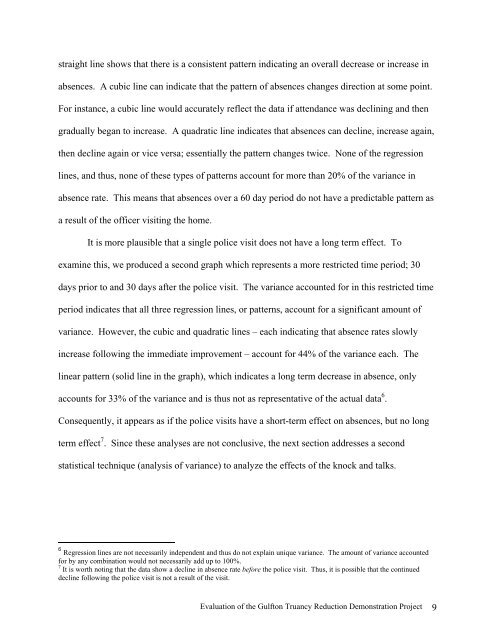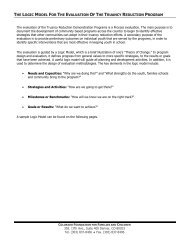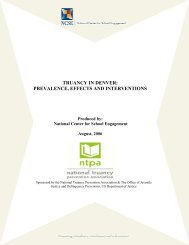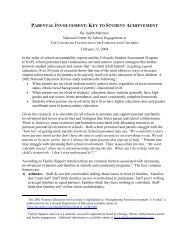Gulfton Truancy Reduction Demonstration Project, Houston, TX
Gulfton Truancy Reduction Demonstration Project, Houston, TX
Gulfton Truancy Reduction Demonstration Project, Houston, TX
Create successful ePaper yourself
Turn your PDF publications into a flip-book with our unique Google optimized e-Paper software.
straight line shows that there is a consistent pattern indicating an overall decrease or increase in<br />
absences. A cubic line can indicate that the pattern of absences changes direction at some point.<br />
For instance, a cubic line would accurately reflect the data if attendance was declining and then<br />
gradually began to increase. A quadratic line indicates that absences can decline, increase again,<br />
then decline again or vice versa; essentially the pattern changes twice. None of the regression<br />
lines, and thus, none of these types of patterns account for more than 20% of the variance in<br />
absence rate. This means that absences over a 60 day period do not have a predictable pattern as<br />
a result of the officer visiting the home.<br />
It is more plausible that a single police visit does not have a long term effect. To<br />
examine this, we produced a second graph which represents a more restricted time period; 30<br />
days prior to and 30 days after the police visit. The variance accounted for in this restricted time<br />
period indicates that all three regression lines, or patterns, account for a significant amount of<br />
variance. However, the cubic and quadratic lines – each indicating that absence rates slowly<br />
increase following the immediate improvement – account for 44% of the variance each. The<br />
linear pattern (solid line in the graph), which indicates a long term decrease in absence, only<br />
accounts for 33% of the variance and is thus not as representative of the actual data 6 .<br />
Consequently, it appears as if the police visits have a short-term effect on absences, but no long<br />
term effect 7 . Since these analyses are not conclusive, the next section addresses a second<br />
statistical technique (analysis of variance) to analyze the effects of the knock and talks.<br />
6 Regression lines are not necessarily independent and thus do not explain unique variance. The amount of variance accounted<br />
for by any combination would not necessarily add up to 100%.<br />
7 It is worth noting that the data show a decline in absence rate before the police visit. Thus, it is possible that the continued<br />
decline following the police visit is not a result of the visit.<br />
Evaluation of the <strong>Gulfton</strong> <strong>Truancy</strong> <strong>Reduction</strong> <strong>Demonstration</strong> <strong>Project</strong> 9










